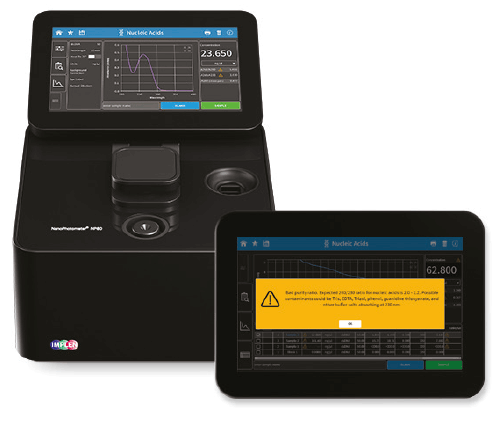Technical Note 10 – Sample Control™ Technology for Nucleic Acid and Protein Quantification
Measurements in a drop have become state-of-the-art and very simple to do over the past two decades, however, there are some areas where sample handling errors and/or contaminations may impact the quality of measurement results. With NanoPhotometer® Sample Control™, we have created a valuable tool to cover main areas of concern (air bubbles, insufficient cleaning and/or unwanted residuals, etc.) ensuring that researchers always can trust their readings.
How NanoPhotometer® Sample Control™ works
Nucleic Acid samples often contain contaminants (e.g. phenol, guanidine, proteins, etc.) from the extraction process, which may be critical inhibitors for downstream applications like sequencing, qPCR, etc.
NanoPhotometer® Sample Control™ will alert the researcher and flag the sample right after the measurement to make sure that the readings will get the attention needed. Sample Control™ will also give an indication of what has been
identified and will direct the user to what needs to be done to obtain better results.

Figure 1: NanoPhotometer® NP80 and a warning screen “Bad purity ratio. Expected 260/230 ratio for nucleic acids is 2.0 – 2.2. Possible contaminants could be Tris, EDTA, Trizol, phenol, guanidine thiocyanate, and other buffer salts absorbing at 230 nm.”
Chemometry vs. Notifications/Alerts
Some UV/Vis spectrophotometer software packages are offering chemometric algorithms to not only identify contaminants in samples, but to also give an estimate of how much the readings are influenced by the contaminant to suggest corrected values based on these calculations. This sometimes includes a parallel determination of DNA and RNA to potentially overcome the need to run other analytical methods for the analysis. All chemometric approaches are heavily depending on the nature of the sample (mammalian, bacterial, plant, yeast, tumor, FFPE, etc.) and the matrix that the sample is present in (different salts, organic components, pH values, etc.). The usability of those calculations is therefore limited to very dedicated combinations of samples and certain clearly defined sample environments. In addition those results cannot be verified easily, which makes it very difficult for a researcher to confirm and trust the corrected sample concentration and quality. These restrictions include nucleic acid and protein samples equally.
NanoPhotometer® Sample Control™ in comparison sends alerts to inform clients about a contamination or handling error, flags the sample, and notifies the researcher of where the contamination/issue might come from and how to improve the quality of the sample. Sample Control™ provides researchers with reliable feedback that can be verified and is independent of the nature of the sample.
Sample Column Breakage/Bridge Testing
The unique optical setup of the NanoPhotometer® does not require sample surface tension, prevents evaporation, and does not need reconditioned surfaces on the pedestal. It is not necessary to check for sample column breakage or bridge testing which may occur in nanovolume spectrophotometers using alternative measurement techniques.
NanoPhotometer® Sample Control™ Summary
NanoPhotometer® Sample Control™ is a valuable tool to help researchers monitoring sample and measurement data quality during the entire workflow. It provides the following main features:
- Sample Contamination / Sample Purity Alerts and Notifications
- Handling Errors / Cleaning Alerts (air bubbles, lint residues, bad samples)
For further questions or if assistance is needed, please contact your local Implen Support Team at [email protected] or [email protected].